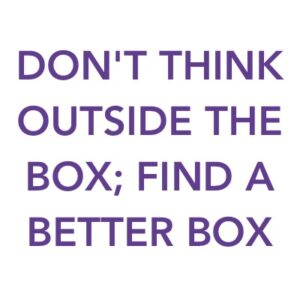 This is tip 4 from Best Practices are Stupid and is the basis of my Invisible Solutions® book. It is fundamental to all of my work with innovation: Start with a well-framed opportunity. Here is a snippet of the text for this chapter…
This is tip 4 from Best Practices are Stupid and is the basis of my Invisible Solutions® book. It is fundamental to all of my work with innovation: Start with a well-framed opportunity. Here is a snippet of the text for this chapter…
Leaders of organizations often use the expression, “think outside the box” while urging their employees to innovate. The belief is that eliminating constraints and allowing people to think freely will increase creativity.
Although this Tabula Rasa or blank slate method to innovation is conventional wisdom, this unbounded approach actually reduces creativity and leads to abstract or impractical solutions. A television script writer in Hollywood once told me that he liked the idea of “creativity within constraints” as it gave him a starting point and then he could “riff” from there.
Instead of telling your employees to think outside the box, give them a “better box” to innovate inside of. These constraints will increase creativity and lead to useful solutions.
Albert Einstein is quotes as saying, “If I had an hour to save the world, I would spend 59 minutes defining the problem and one minute finding solutions.” In my experience, most companies spend the full sixty minutes finding solutions to problems that just don’t matter.
Well-defined challenges guide innovation efforts, provide useful constraints, and define that “better box.”
Challenge-Centered Innovation
Let’s face it: your organization has no shortage of opportunities or problems, and you can find them everywhere: from your customers, employees, shareholders, consultants, vendors, competitors, and more.
An organization’s ability to change (i.e. innovate) hinges on its ability to identify and solve these challenges.
Why Challenge-Centered Innovation?
There are a number of inherent advantages to using a challenge-centered approach over an idea-driven approach to innovation:
- Challenges are the best way to ask your employees, customers, or any community for help. It allows them to focus their energies on finding solutions that will ultimately be relevant to the needs of the organization.
- When done properly, you can measure the ROI of each challenge and the overall challenge-driven program.
- With a challenge-centered approach, you can assign owners, sponsors, resources and funding, evaluators, and evaluation criteria before investing the valuable time of employees and others.
The idea-driven approach to innovation does not allow for any of the above. With well-defined challenges, all of these are possible.
Establishing boundaries does not necessarily put constraints on innovation efforts. In actuality, if done correctly, it has the capacity to dramatically enhance creativity and increase organizational effectiveness. So, the next time you are tempted to say “Think outside the box” – think again.
P.S. A few additional points:
- The post above is a condensed version of the actual text
- The Einstein quote is a shorthand for what he actually said: “The mere formulation of a problem is far more often essential than its solution… To raise new questions, new possibilities, to regard old problems from a new angle requires creative imagination and marks real advances in science.”
- Clients have one quantitative studies and proved that the ROI on challenges was 10x great than those with ideas (sometimes a lot more)
- Learn more about Invisible Solutions here: https://stephenshapiro.com/invisible-solutions/

